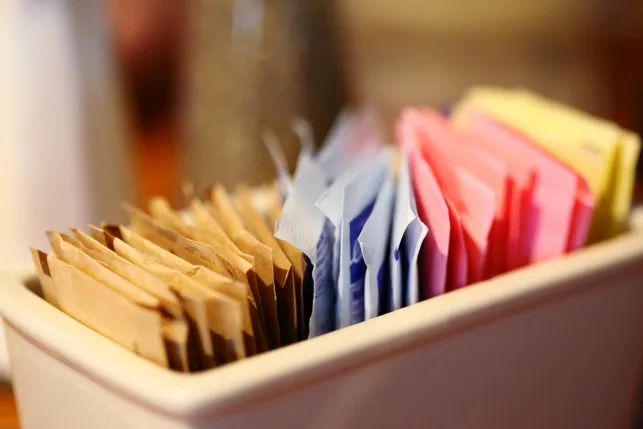An sweetener is any substance that gives a sweet taste to a food, either of natural or artificial origin, whether caloric or height.
They can be classified according to several characteristics: chemicals, origin or caloric contribution.
Classification
According to the classification of the chemical structure we can find:
sugars
- Sucrose (common sugar)
- Glucose
- Agave syrup
- Maltosa
- Lactose
- Fructose
- Sucralosa*
Sugars are carbohydrates of natural origin that are absorbed in their entirety quickly and found in foods such as fruit, milk or honey.The World Health Organization recommends that its consumption contribute less than 10% of the total calories of the day.
*Sucralose is obtained from modifying sucrose which makes it not absorbed and does not increase blood glucose.One of the advantages of the succalose is that it can be used in cooked products such as pastry products.
Polialcohols or polyes
- Isomalt
- Lacitol
- Manitol
- Maltitol
- Sorbitol
- Xilitol
Polyles or Polialcohols are sweeteners that are obtained from modifying sugars, which makes the absorption partial.The approximate absorption of these sweeteners is considered to be 50% and slowly.
You must be special care with young children or people sensitive to polyles since excessive consumption can cause digestive discomfort and even have laxative effects.
amino acids or proteins
- Acesulfamo k
- Alithamo
- Aspartamo
- Cylamate
- Stevósido (Estevia)
- Neohesperidine
- Neotame
- Sarrin
- Taumatin
Protein sweeteners are of natural and artificial origin, but none increases glycemia after consumption.
Security
Food security legislation varies depending on the body that regulates it.Thus we can find that an sweetener can be prohibited in the United States and not be in other countries.Official organizations (FDA, EFSA ...) periodically review the state of scientific evidence on the properties and possible adverse effects on health and issue opinion reports on the safety of these compounds.
At present there is a certain degree of social alarm with artificial sweeteners.It should be noted that at present these substances are subject to studies and surveillance to ensure the health of the population.
However, there is the idea that sweeteners of natural origin are innovate or even beneficial for health.
It should be noted that any sweetener (natural or artificial) has a recommended maximum daily dose.Even table sugar is a sweetener that should not be abused, since it favors the appearance of caries, overweight and in some cases obesity.
It is necessary to look at the product indications and not exceed the dose they recommend, since in this way we ensure not to exceed the admissible daily amount that is the amount that is not detrimental to health.
culinary uses
Caloric sweeteners (sugars except succral) are widely used as ingredients in food products.
However, low -calorie products, without added sugars or with other claims, contain non -caloric sweeteners.Some of the most used are aspartamo, acesulfamo, sucralous, saccharin, stevia or cyclamate.According to the country where the product is allocated, some sweeteners or others are more used.Anyway, sweeteners such as sucralose, Estevia or polyes are becoming more frequent.
In addition to food, sweeteners can also be acquired for personal use, both to sweeten food and for recipes.
Artificial sweeteners in general are resistant to high temperatures, butSome do not keep intact the sweet taste that characterizes them.Some of the sweeteners with good acceptance for the preparation of hot or baked recipes are sucralose, polyles, ciclamate saccharin or stevia.
Considerations on the HC count
You must have some sweeteners are marketed powder.This powder is composed of maltodextrin (a slow absorption carbohydrate) that give the edulcorant volume.
For this reason we can find that in the composition per 100 grams of product contains a negligible amount of carbohydrates.The amount used must be taken into account, since if 1 or 2 grams of product are served, it is not necessary to take into account those carbohydrates.
Sucralosa -based sweetening 
For the calculation of carbohydrates rations from food labeling, the total carbohydrate value must usually take into account.
However, in the case of products with polyes (50% absorption) it will be necessary to subtract 50% of the amount of polyles (amount that is not going to be absorbed) to the total carbohydrates indicated by the product table.
We put as an example the labeling of María Cookies with sugar and cookies Maria 0% sugars sweetened with polyles.
Cookie María
Ingredients: flour, sugar, vegetable fat, glucose and fructose syrup, milk serum, gasifying, salt, aromas ...
As can be seen the sweetened sweeteners are sugars, so the total of them are absorbed.
In this case, for the HC ration counting we must take into account the total carbohydrates, not sugars.
Example: 100g of cookie contains 63.89 gde hydrates.So a ration of HC (10g of HC) is equivalent to (100 × 10) /63.89 = 15.65g of cookie (approximately 3 cookies).
Maria 0% sugars 
Ingredients: flour, sweetener (Maltitol syrup), vegetable fat, glucose syrup and fructose, milk serum, gasifying, salt, aromas ...
As can be seen the sweetened sweeteners are polyles, so not all carbohydrates indicated by the table will be absorbed.
In this case, for the HC ration count we must take into account that polyles are absorbed to 50%.Thus we must subtract 50% of the value of the polyles (part that is not absorbed) to the total of the carbohydrates indicated.
Example: 100g of cookie contains 71.5 GDE hydrates.Of which 15.6 are polyles.
15.6/2 = 7.8g of polyles that are not absorbed.
So the carbohydrates of the cookie that are absorbed are: 71.5 - 7.8 = 63.7g.Thus a ration of HC (10g of HC) is equivalent to (100 × 10) /63.7 = 15.69g of cookie (approximately 3 cookies).
In the section "How to read nutritional labels" you will find more examples of ration calculations from product labels.










